Functional circuitry of the retinal ganglion cell's nonlinear receptive field
- PMID: 10559385
- PMCID: PMC6782950
- DOI: 10.1523/JNEUROSCI.19-22-09756.1999
Functional circuitry of the retinal ganglion cell's nonlinear receptive field
Abstract
A retinal ganglion cell commonly expresses two spatially overlapping receptive field mechanisms. One is the familiar "center/surround," which sums excitation and inhibition across a region somewhat broader than the ganglion cell's dendritic field. This mechanism responds to a drifting grating by modulating firing at the drift frequency (linear response). Less familiar is the "nonlinear" mechanism, which sums the rectified output of many small subunits that extend for millimeters beyond the dendritic field. This mechanism responds to a contrast-reversing grating by modulating firing at twice the reversal frequency (nonlinear response). We investigated this nonlinear mechanism by presenting visual stimuli to the intact guinea pig retina in vitro while recording intracellularly from large brisk and sluggish ganglion cells. A contrast-reversing grating modulated the membrane potential (in addition to the firing rate) at twice the reversal frequency. This response was initially hyperpolarizing for some cells (either ON or OFF center) and initially depolarizing for others. Experiments in which responses to bars were summed in-phase or out-of-phase suggested that the single class of bipolar cells (either ON or OFF) that drives the center/surround response also drives the nonlinear response. Consistent with this, nonlinear responses persisted in OFF ganglion cells when ON bipolar cell responses were blocked by L-AP-4. Nonlinear responses evoked from millimeters beyond the ganglion cell were eliminated by tetrodotoxin. Thus, to relay the response from distant regions of the receptive field requires a spiking interneuron. Nonlinear responses from different regions of the receptive field added linearly.
Figures

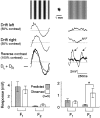
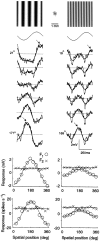

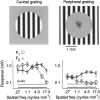
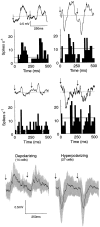
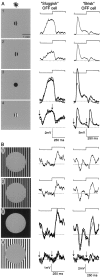

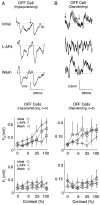


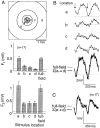

Similar articles
-
Bipolar cells contribute to nonlinear spatial summation in the brisk-transient (Y) ganglion cell in mammalian retina.J Neurosci. 2001 Oct 1;21(19):7447-54. doi: 10.1523/JNEUROSCI.21-19-07447.2001. J Neurosci. 2001. PMID: 11567034 Free PMC article.
-
Parallel ON and OFF cone bipolar inputs establish spatially coextensive receptive field structure of blue-yellow ganglion cells in primate retina.J Neurosci. 2009 Jul 1;29(26):8372-87. doi: 10.1523/JNEUROSCI.1218-09.2009. J Neurosci. 2009. PMID: 19571128 Free PMC article.
-
Effect of spike blockade on the receptive-field size of amacrine and ganglion cells in the rabbit retina.J Neurophysiol. 1996 May;75(5):1878-93. doi: 10.1152/jn.1996.75.5.1878. J Neurophysiol. 1996. PMID: 8734587
-
Distinct synaptic mechanisms create parallel S-ON and S-OFF color opponent pathways in the primate retina.Vis Neurosci. 2014 Mar;31(2):139-51. doi: 10.1017/S0952523813000230. Epub 2013 Jul 29. Vis Neurosci. 2014. PMID: 23895762 Free PMC article. Review.
-
Six different roles for crossover inhibition in the retina: correcting the nonlinearities of synaptic transmission.Vis Neurosci. 2010 Mar;27(1-2):1-8. doi: 10.1017/S0952523810000076. Epub 2010 Apr 15. Vis Neurosci. 2010. PMID: 20392301 Free PMC article. Review.
Cited by
-
Responses of recurrent nets of asymmetric ON and OFF cells.J Biol Phys. 2011 Mar;37(2):189-212. doi: 10.1007/s10867-010-9207-3. Epub 2010 Nov 20. J Biol Phys. 2011. PMID: 22379229 Free PMC article.
-
Inhibitory mechanisms that generate centre and surround properties in ON and OFF brisk-sustained ganglion cells in the rabbit retina.J Physiol. 2013 Jan 1;591(1):303-25. doi: 10.1113/jphysiol.2012.243113. Epub 2012 Oct 8. J Physiol. 2013. PMID: 23045347 Free PMC article.
-
Receptive field center-surround interactions mediate context-dependent spatial contrast encoding in the retina.Elife. 2018 Sep 6;7:e38841. doi: 10.7554/eLife.38841. Elife. 2018. PMID: 30188320 Free PMC article.
-
Contrast adaptation in subthreshold and spiking responses of mammalian Y-type retinal ganglion cells.J Neurosci. 2005 Jan 26;25(4):860-8. doi: 10.1523/JNEUROSCI.2782-04.2005. J Neurosci. 2005. PMID: 15673666 Free PMC article.
-
Synaptic currents generating the inhibitory surround of ganglion cells in the mammalian retina.J Neurosci. 2001 Jul 1;21(13):4852-63. doi: 10.1523/JNEUROSCI.21-13-04852.2001. J Neurosci. 2001. PMID: 11425912 Free PMC article.
References
-
- Benardete EA, Kaplan E, Knight BW. Contrast gain control in the primate retina: P cells are not X-like, some M cells are. Vis Neurosci. 1992;8:483–486. - PubMed
-
- Bloomfield SA. Effect of spike blockade on the receptive-field size of amacrine and ganglion cells in the rabbit retina. J Neurophysiol. 1996;75:1878–1893. - PubMed
-
- Bolz J, Wässle H, Thier P. Pharmacological modulation of ON and OFF ganglion cells in the cat retina. Neuroscience. 1984;12:875–885. - PubMed
Publication types
MeSH terms
Substances
Grants and funding
LinkOut - more resources
Full Text Sources
Miscellaneous
